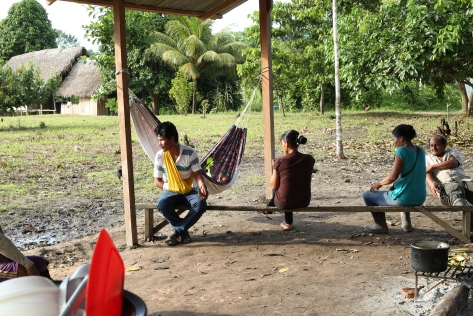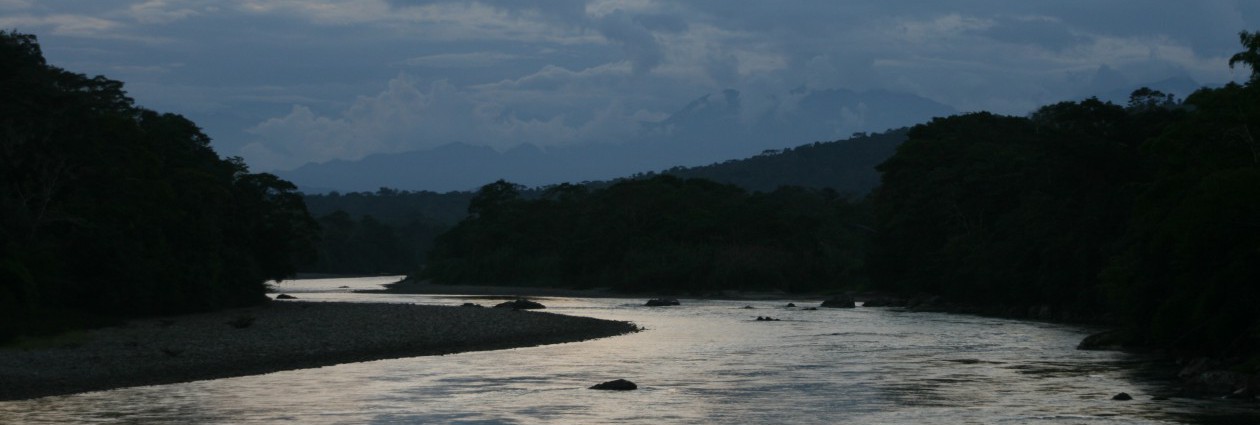We finally arrived to the community of San Mateo, the last community on the river before entering Brazil. We were greeted at the shore by a handful of children and adults all very excited to see us. Several of them were in a fruit tree hanging over the clay embankment along the river. One child dropped down a piece of fruit for me, which was about the size of a pear and bright red. If you were to try and imagine what a rose would taste like, but sweet- that is what I would compare it to. I later found out that the name of the fruit is Pumarosa (rosa meaning “rose” in Spanish). After meeting some of the members of the community and being shown around a bit, we headed to the field to play soccer. The community was small, from what I could tell containing no more than 40-50 people in total. The houses were made of wood and were held up on stilts, with palm thatch roofs. Each house contained one enclosed area, and an open area usually with a hammock or two hanging from the support beams. Chickens and ducks ran freely with dogs all throughout the community. I stood out in the field and admired the community surrounded by thick jungle as we prepared for our game. This is the farthest that I had ever been from civilization, and it felt great. The air had a fresh, sweet aroma to it. I watched a flock of parrots fly by- and then I heard the sound of the bird that I have been waiting all of my life to hear in the wild: macaws. I turned around, and on top of a large palm tree saw two of them perched on a branch chattering with each other. I was the first time in my life that I had ever seen them flying and living as freely as they were. Shortly after I heard the familiar sound once again, and watched a flock of eight bright emerald green macaws fly above me across the blue sky. I couldn’t take my eyes off of them. All of my life I have been wanting to experience what I just did in those ten or fifteen seconds that I watched them fly over me.



That night we had dinner with the community, which was soup and spaghetti noodles with a piece of venison (deer) along with a drink that they made out of fermented yucca, a plant that grows indigenous to the Amazon- which is basically prepared as you would a potato. It was prepared in a large plastic tub with water, and then served. Normally I will try anything, although I wasn’t sure of where they got the water. Many people in the forest drink from the river, and it could possibly cause some stomach problems if you aren’t accustomed to it- or you could get a parasite. Beside me was a small girl with a baby monkey on her head, clinging to her long dark brown hair. It squealed every time that someone tried to touch it. I wondered what had happened to the mother, although more than likely she was eaten. The area where they prepared their meals was held under a tin roof supported by six large beams. In the center was an iron grill sitting on four small legs on the ground, with hot charcoals underneath. They would put their pots on top of the grill to cook and prepare their food. Several chairs and benches were underneath the canopy as well as a hammock, where the adults sat comfortably chattering amongst each other as we ate.

Later that night we had a meeting in one of the buildings to discuss what it is that we had planned to do for the community. They were able to get a generator going so that we had power, and were able to set up a laptop and projector so that we could give a PowerPoint presentation. Everything was explained with how the different steps are necessary to help a community gain rights to their land. With us we had several members of the Peruvian Department of Agriculture, who would be working with the land as well as taking soil samples.
The next day I set out with one of the members of the Department of Agriculture to document the process. With us were several people from San Mateo. We traveled in a small wooden canoe equipped with a good sized motor. The majority of the motors that I had seen since then are unlike any that I have ever seen in my life. Rather than the propeller dropping down straight below the boat, instead it is connected to a long pole about eight feet in length, with the propeller at the very end of the pole. On the opposite end of the motor is a long steel rod that that continues for another two feet which is used to steer the motor. The motor rests on a short steel rod that sits inside of a wooden hole on a board in the back of the boat. It is made this way so that the motorista is able to raise the propeller as high or as low in the water as they would like so that they won’t hit any debris. We went to several different locations, exiting the boats and trudging through the mud while hacking our way with a machete through jungle thicker than I have ever seen. Led by a GPS, once the edge of the territory was found a 15 ft parameter was cleared and the area was marked with a wooden post (which was made on site) and then spray painted with the name of the community, and then documented. This was the process until mid-afternoon, when we returned to the community. I took some pictures of the community as well as gave several interviews to the people who live there in addition to members of our own team where I was able to learn a little more about the agriculture within the community and the length of time that people have been living there. It really was a beautiful place, far from the chaos of the city and all of the pollution. I climbed one of the fruit trees with a group of children and then spent some time speaking with the adults, who were near the cooking pot where we had dinner. They gave me some grief about being 27 and not married or having any children, and jokingly tried to give me several of their children to bring home with me. I glanced over at the forest just behind the palm thatch houses which I so badly wanted to explore to search for the giant trees that I knew existed there.

I spoke with one of the members of the team that night about the river, and he told me several stories about things that he claim live at the bottom of the river and only come out at night. He said that there are fish that exist in the rivers that are larger than the river dolphins that I had seen several days ago, fish large enough to swallow a human. He said that some time ago he had a run in with several of them while traveling at night with his boat. There was a time when he hit something that wasn’t mud, sand or a tree- and stopped them in the water. When his friend put his foot in the water to push the canoe he felt skin on his bare foot, the type of skin that one would expect to come from a fish. I took the opportunity to ask him about other native species since he was from the area. He told me about anacondas that were large enough to eat a person, or crush a canoe by wrapping itself around it. There are few places in the world where there are animals that exists of this size, and I consider myself very fortunate to be able to travel to a place where they live.

Great Post
LikeLike
Amazing. You are such an adventurer and a lovely writer! I feel like in was there, your descriptions and feelings about this place make me want to play with the children, eat some food with the community members, explore the jungle. You are so blessed!
LikeLike